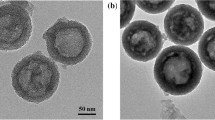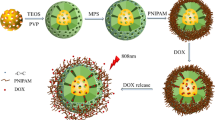Abstract
A multifunctional drug delivery system (GNRs@mSiO2-HA-RGD) was developed by conjugating targeting ligand hyaluronic acid (HA) and RGD with mesoporous silica- coated gold nanorods (GNRs@mSiO2) for dual-targeted chemo-photothermal therapy. The physiochemical properties of the prepared nanoparticles were characterized by FTIR, UV-vis spectra, and 1H NMR. Doxorubicin hydrochloride (DOX), an anticancer drug, was used as the model drug to investigate the drug loading, in vitro drug release profiles and cytotoxicity. The experimental results show that DOX-GNRs@mSiO2-HA-RGD is synthesized with a mean diameter of 116 nm and a sufficient load capacity of about 19.8%. It also has pH-enzyme sensitive and NIRtriggered drug release manner. Cellular uptake indicates that DOX-GNRs@mSiO2-HA-RGD exhibits a higher cellular uptake via CD44 receptor and integrin receptor mediated endocytosis compared with the GNRs@ mSiO2 modified with one receptor or no receptor. In comparison with chemotherapy or photothermal therapy alone, DOX-GNRs@mSiO2-HA-RGD displayes the synergistic effects and achieves a higher therapeutic efficacy. It can be expected that DOX-GNRs@mSiO2-HA-RGD is a potential dual-targeted chemo-photothermal therapeutic platform for effective cancer treatment.
Similar content being viewed by others
References
Zubrod CG, Schneiderman M, Frei E, et al. Appraisal of Methods for the Study of Chemotherapy of Cancer in Man: Comparative Therapeutic Trial of Nitrogen Mustard and Triethylene Thiophosphoramide[J]. Journal of Chronic Diseases, 1960, 11(1): 7–33
Shankar S, Srivastava RK. Enhancement of Therapeutic Potential of TRAIL by Cancer Chemotherapy and Irradiation: Mechanisms and Clinical Implications[J]. Drug Resistance Updates, 2004, 7(2): 139–156
Pastorino F, Brignole C, Di Paolo D, et al. Targeting Liposomal Chemotherapy Via Both Tumor Cell-specific and Tumor Vasculature-specific Ligands Potentiates Therapeutic Efficacy[J]. Cancer Research, 2006, 66(20): 10 073–10 082
Kintzel PE, Dorr RT. Anticancer Drug Renal Toxicity and Elimination: Dosing Guidelines for Altered Renal Function[J]. Cancer Treatment Reviews, 1995, 21(1): 33–64
Tacar O, Sriamornsak P, Dass CR. Doxorubicin: An Update on Anticancer Molecular Action, Toxicity and Novel Drug Delivery Systems[J]. Journal of Pharmacy and Pharmacology, 2013, 65(2): 157–170
Bracci L, Schiavoni G, Sistigu A, et al. Immune-based Mechanisms of Cytotoxic Chemotherapy: Implications for the Design of Novel and Rationale-based Combined Treatments Against Cancer[J]. Cell Death & Differentiation, 2014, 21(1): 15–25
Wust P, Hildebrandt B, Sreenivasa G, et al. Hyperthermia in Combined Treatment of Cancer[J]. The Lancet Oncology, 2002, 3(8): 487–497
Kulshrestha P, Gogoi M, Bahadur D, et al. In vitro Application of Paclitaxel Loaded Magnetoliposomes for Combined Chemotherapy and Hyperthermia[J]. Colloids and Surfaces B: Biointerfaces, 2012, 96: 1–7
Ciofani G, Riggio C, Raffa V, et al. A Bi-modal Approach Against Cancer: Magnetic Alginate Nanoparticles for Combined Chemotherapy and Hyperthermia[J]. Medical Hypotheses, 2009, 73(1): 80–82
O’Neal DP, Hirsch LR, Halas NJ, et al. Photo-thermal Tumor Ablation in Mice Using Near Infrared-absorbing Nanoparticles[J]. Cancer Letters, 2004, 209(2): 171–176
Tong L, Wei Q, Wei A, et al. Gold Nanorods as Contrast Agents for Biological Imaging: Optical Properties, Surface Conjugation and Photothermal Effects[J]. Photochemistry and Photobiology, 2009, 85(1): 21–32
Huang X, El-Sayed IH, Qian W, et al. Cancer Cell Imaging and Photothermal Therapy in the Near-infrared Region by Using Gold Nanorods[J]. Journal of the American Chemical Society, 2006, 128(6): 2 115–2 120
Chen J, Glaus C, Laforest R, et al. Gold Nanocages as Photothermal Transducers for Cancer Treatment[J]. Small, 2010, 6(7): 811–817
Shi X, Gong H, Li Y, et al. Graphene-based Magnetic Plasmonic Nanocomposite for Dual Bioimaging and Photothermal Therapy[J]. Biomaterials, 2013, 34(20): 4 786–4 793
Shen S, Tang H, Zhang X, et al. Targeting Mesoporous Silica-encapsulated Gold Nanorods for Chemo-photothermal Therapy with Near-infrared Radiation[J]. Biomaterials, 2013, 34(12): 3 150–3 158
Zhang X, Guo C, Wang X, et al. Synthesis and Characterization of Bimodal Mesoporous Silica[J]. Journal of Wuhan University of Technology- Mater. Sci. Ed., 2012, 27(6): 1 084–1 088
Zhang Z, Wang L, Wang J, et al. Mesoporous Silica-coated Gold Nanorods as a Light-mediated Multifunctional Theranostic Platform for Cancer Treatment[J]. Advanced Materials, 2012, 24(11): 1418–1423
Huang P, Bao L, Zhang C, et al. Folic Acid-conjugated Silica-modified Gold Nanorods for X-ray/CT Imaging-guided Dual-mode Radiation and Photo-thermal Therapy[J]. Biomaterials, 2011, 32(36): 9 796–9 809
Zhang L, Chen Y, Xu H, et al. Preparation and Evaluation of an Injectable Chitosan-hyaluronic Acid Hydrogel for Peripheral Nerve Regeneration[J]. Journal of Wuhan University of Technology-Mater. Sci. Ed., 2016, 31(6): 1 401–1 407
Hu Y, Zheng M, Dong X, et al. Preparation and Characterization of Alginate- hyaluronic Acid-chitosan Based Composite Gel Beads[J]. Journal of Wuhan University of Technology-Mater. Sci. Ed., 2015, 30(6): 1 297–1 303
Yu M, Jambhrunkar S, Thorn P, et al. Hyaluronic Acid Modified Mesoporous Silica Nanoparticles for Targeted Drug Delivery to CD44-overexpressing Cancer Cells[J]. Nanoscale, 2013, 5(1): 178–183
Hodivala-Dilke K. αvβ3 Integrin and Angiogenesis: a Moody Integrin in a Changing Environment[J]. Current Opinion in Cell Biology, 2008, 20(5): 514–519
Zitzmann S, Ehemann V, Schwab M. Arginine-glycine-aspartic Acid (RGD)-peptide Binds to both Tumor and Tumor-endothelial Cells in Vivo[J]. Cancer Research, 2002, 62(18): 5 139–5 143
Ouasti S, Kingham PJ, Terenghi G, et al. The CD44/Integrins Interplay and the Significance of Receptor Binding and Re-presentation in the Uptake of RGD-functionalized Hyaluronic Acid[J]. Biomaterials, 2012, 33(4): 1 120–1 134
Xu H, Wang Z, Li Y, et al. Preparation and Characterization of a Dual- receptor Mesoporous Silica Nanoparticle-hyaluronic Acid-RGD Peptide Targeting Drug Delivery System[J]. RSC Advances, 2016, 6(46): 40 427–40 435
Nikoobakht B, El-Sayed MA. Preparation and Growth Mechanism of Gold Nanorods (NRs) Using Seed-mediated Growth Method[J]. Chemistry of Materials, 2003, 15(10): 1 957–1 962
Gorelikov I, Matsuura N. Single-step Coating of Mesoporous Silica on Cetyltrimethyl Ammonium Bromide-capped Nanoparticles[J]. Nano letters, 2008, 8(1): 369–373
Riddick TM. Control of Colloid Stability through Zeta Potential: With a Closing Chapter on Its Relationship to Cardiovascular Disease[M]. Zeta-Meter, Incorporated, 1968
Tian H, Lin L, Chen J, et al. RGD Targeting Hyaluronic Acid Coating System for PEI-PBLG Polycation Gene Carriers[J]. Journal of Controlled Release, 2011, 155(1): 47–53
Ko H, Son S, Bae S, et al. Near-infrared Light-triggered Thermochemotherapy of Cancer Using a Polymer-gold Nanorod Conjugate[J]. Nanotechnology, 2016, 27(17): 175102–1751014
Lim YT, Noh YW, Han JH, et al. Biocompatible Polymer-Nanoparticle- Based Bimodal Imaging Contrast Agents for the Labeling and Tracking of Dendritic Cells[J]. Small, 2008, 4(10): 1640–1645
Chen LB, Zhang F, Wang CC. Rational Synthesis of Magnetic Thermosensitive Microcontainers as Targeting Drug Carriers[J]. Small, 2009, 5(5): 621–628
Bordon KCF, Perino MG, Giglio JR, et al. Isolation, Enzymatic Characterization and Antiedematogenic Activity of the First Reported Rattlesnake Hyaluronidase from Crotalus durissus Terrificus Venom[J]. Biochimie, 2012, 94(12): 2 740–2 748
Zhang W, Guo Z, Huang D, et al. Synergistic Effect of Chemo-photothermal Therapy Using PEGylated Graphene Oxide[J]. Biomaterials, 2011, 32(33): 8 555–8 561
Author information
Authors and Affiliations
Corresponding authors
Additional information
Funded by the National Natural Science Foundation of China (Nos. 51473130 and 51572206), the Wuhan Huanghe excellence plan and Entrepreneurship Training Program of Wuhan University and Technology (Nos. 20171049720018, 20171049720019, and 20171049720009)
Rights and permissions
About this article
Cite this article
Zhou, H., Gao, Y., Xu, H. et al. Hyaluronic Acid-RGD Peptide Conjugated Mesoporous Silica-coated Gold Nanorods for Cancer Dual-targeted Chemo-photothermal Therapy. J. Wuhan Univ. Technol.-Mat. Sci. Edit. 33, 512–523 (2018). https://doi.org/10.1007/s11595-018-1853-4
Received:
Accepted:
Published:
Issue Date:
DOI: https://doi.org/10.1007/s11595-018-1853-4




